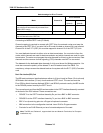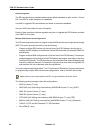
Specifications
Release 3.3 99
The following protocols support Network-side configurations:
• 4ESS (Custom) (T1 only)
• DMS 100 (Nortel Custom) (T1 only)
• DMS 250 (Nortel Custom) (T1 only)
• BellCore (NI2) (NI3 Calling name delivery) NI99 SR4619 spec (T1 only) (Siemens)
• Q.SIG E1 (ETSI and ISO Standard) T1 (ISO Standard)
• Euro-ISDN (E1 only)
R2 Card
The R2 card is a protocol converter that allows the 300 ICP system to access an R2 National
Public Switched Telephone Network (PSTN) with MF-R2 digital trunk signaling. The card also
receives and processes Calling Line Identification (CLI) and allows the information to be
displayed on the user's telephone display screen. The R2 card converts the following:
• Incoming MF-R2 signals from the PSTN into Digital Private Network Signaling System
(DPNSS) signals for the 3300 ICP system.
• Outgoing DPNSS signals from the 3300 ICP into MF-R2 signals for the PSTN.
R2 signaling
Although many countries use R2 signaling, most do not adhere to the CCITT recommendations
in their entirety, and there are many protocol variations around the world. R2 support on the
3300 ICP system provides exceptional flexibility, which enables you to support the regional
variations in the R2 protocol. Line signaling, tone interpretation, and timing parameters for the
R2 card can be adapted to suit any national or regional requirement. For example:
• Line signaling features allow you to program up to four bits to define the incoming and
outgoing patterns for line commands such as Idle and Answer.
• Register signaling features allow you to program the type of address signaling termination
(signaled or timed) and whether signaling should be fully-compelled or semi-compelled.
These features also allow you to define each register signaling tone individually.
Using IMAT (ISDN Maintenance and Administration Tool), you can adapt line signaling, tone
interpretation, and timing parameters for the R2 card to suit any national or regional requirement.
For more information about IMAT, refer to Using the ISDN Maintenance and Administration Tool
(IMAT).
Line Signaling
In the R2 protocol, line signaling is used to begin and terminate the call setup process. Line
signaling features in IMAT allow you to program up to four bits to define the incoming and
outgoing tone patterns for the following line commands:
•Idle
•Seize
• Seize Ack


















